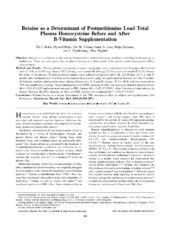Betaine as a determinant of postmethionine load total plasma homocysteine before and after B-Vitamin supplementation
Holm, Pål Ivar; Bleie, Øyvind; Ueland, Per Magne; Lien, Ernst Asbjørn; Refsum, Helga; Nordrehaug, Jan Erik; Nygård, Ottar
Peer reviewed, Journal article
Permanent lenke
https://hdl.handle.net/1956/3120Utgivelsesdato
2004Metadata
Vis full innførselSamlinger
Originalversjon
https://doi.org/10.1161/01.atv.0000114569.54976.31Sammendrag
Objective—Betaine is a substrate in the betaine– homocysteine methyltransferase reaction, converting homocysteine to methionine. There are only sparse data on plasma betaine as a determinant of the plasma total homocysteine (tHcy) concentration. Methods and Results—Ninety patients undergoing coronary angiography were randomized into 4 groups administered oral: (1) folic acid (0.8 mg), vitamin B12 (0.4 mg), and vitamin B6 (40 mg); (2) folic acid and vitamin B12; (3) vitamin B6 alone; or (4) placebo. Nonfasting blood samples were collected at baseline and 3, 14, and 28 days and 3, 6, and 12 months after treatment start. A 4-hour methionine-loading test (0.1 g/kg) was performed at baseline and after 3 months. At baseline, median (interquartile range) plasma betaine was 36.9 mol/L (range: 30.3 to 46.8) and was increased by 15% after methionine loading. The postmethionine load (PML) increase in tHcy was inversely related to plasma betaine ( 0.29, P 0.02) and even more strongly to PML betaine ( 0.47, P 0.001). After 3 months of intervention, the relation between the PML increase in tHcy and PML betaine was weakened ( 0.33, P 0.007). Conclusions—Plasma betaine is a strong determinant of the PML increase in tHcy in subjects not supplemented with B-vitamins.
